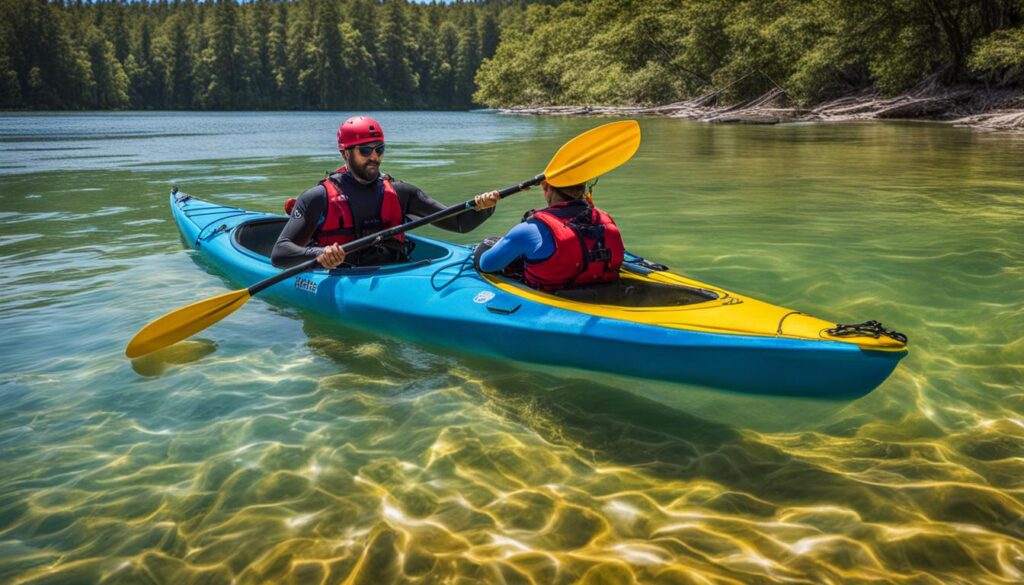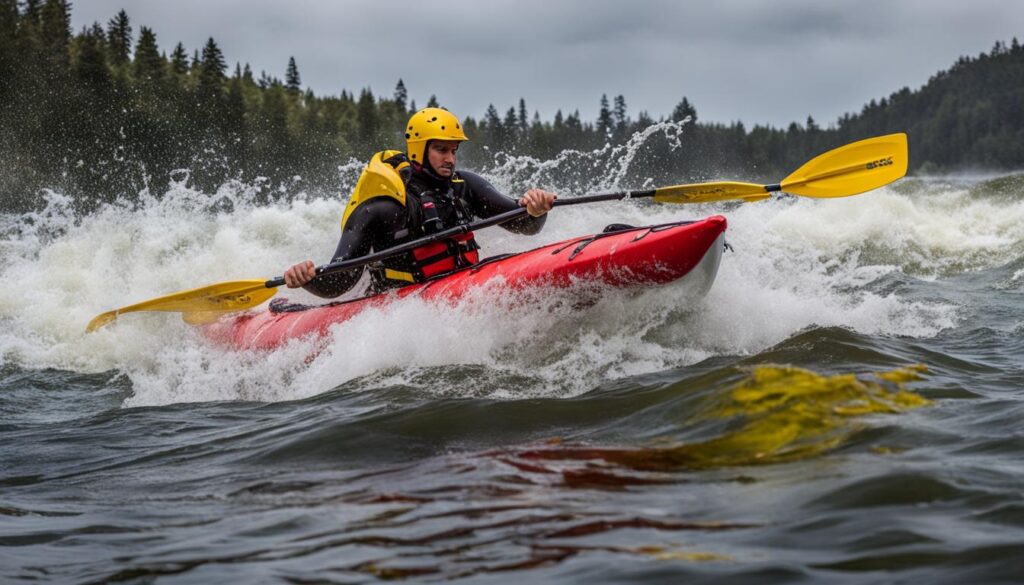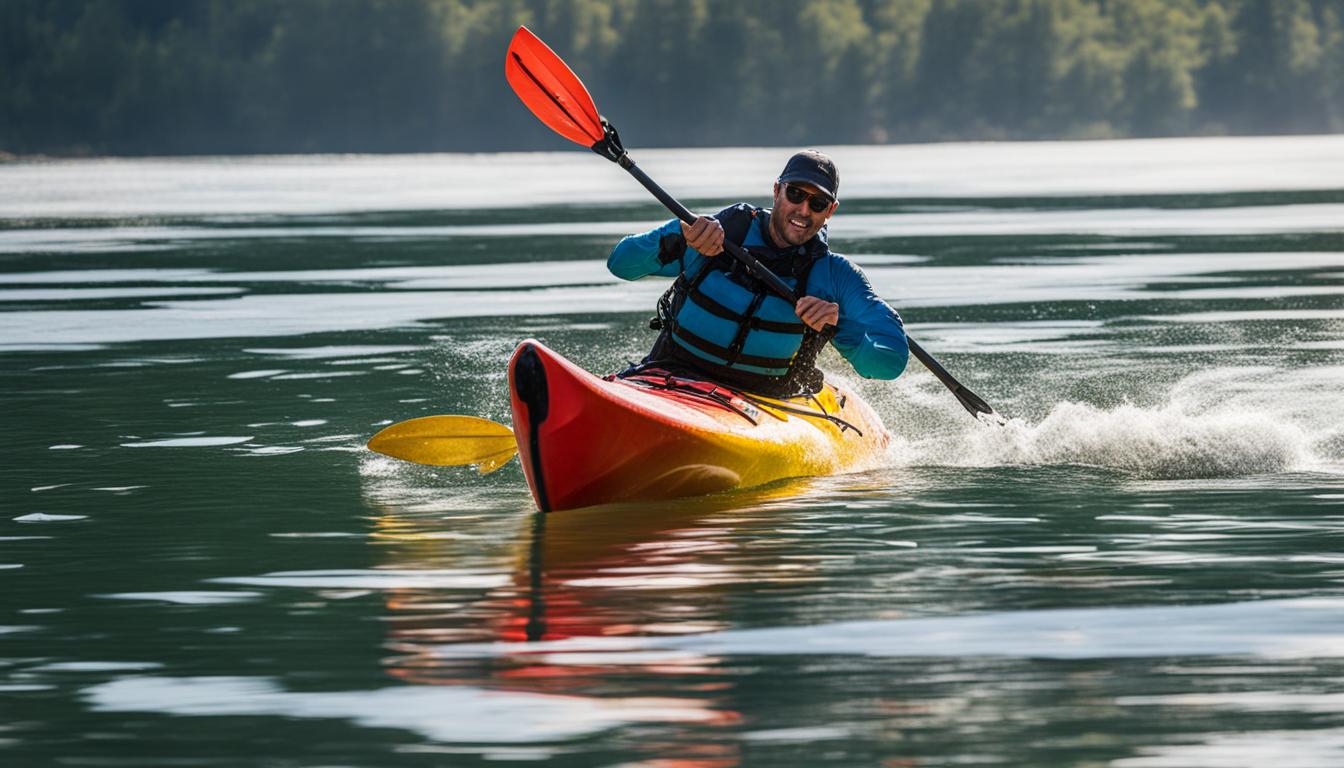Are you a kayaker looking to enhance your safety skills on the water? Then wet exit drills are an essential practice technique you should master. These drills teach you how to safely exit a capsized kayak and build the confidence needed for any situation. In this article, we will explore the importance of wet exit drills, the steps involved, organized practice sessions, different skill levels, rescue techniques, safety tips, and more. By the end, you’ll have a comprehensive understanding of wet exit drills and be prepared for any potential wet exit scenario.
Key Takeaways:
- Wet exit drills are crucial for kayaker safety and confidence.
- Learning and practicing wet exit techniques in a controlled environment is essential.
- Organized wet exit practice sessions provide a safe and supportive setting.
- Wet exit drills can be tailored to different skill levels, including kids and advanced kayakers.
- Rescue techniques and safety protocols are important complements to wet exit drills.
The Importance of Wet Exit Drills
Wet exit drills are a crucial aspect of kayaking safety, providing essential protocols for efficiently and effectively exiting a capsized kayak. Regardless of your skill level, practicing these drills is necessary to improve your wet exit efficiency and build confidence in different water conditions.
By regularly practicing wet exits, you can enhance your ability to react quickly and calmly in real-life scenarios. This is especially important when faced with unexpected challenges such as strong currents or rough waters. Wet exit drills help you develop the muscle memory required to perform the necessary steps in a controlled and efficient manner.
In addition to improving your skills, practicing wet exit drills also allows you to familiarize yourself with the specific safety protocols involved. This includes knowing how to properly locate and remove the spray skirt, as well as understanding the importance of wearing a personal flotation device (PFD) and other protective gear.
Benefits of Wet Exit Drills:
- Enhances response time and efficiency in real-life scenarios
- Builds confidence and reduces panic during capsizing situations
- Improves awareness of safety protocols and protective gear
- Prepares kayakers for different water conditions and challenges
By recognizing the importance of wet exit drills and dedicating time to practicing them, kayakers can significantly enhance their safety and enjoyment on the water. Whether you are a beginner or an experienced kayaker, investing in regular wet exit practice is essential for maintaining your skills and staying prepared for any potential wet exit situation.
Steps to Perform a Wet Exit
Performing a wet exit involves a series of steps that can be easily followed in a calm and controlled environment. By mastering these steps, you can enhance your ability to safely exit a capsized kayak and minimize the risks associated with water emergencies.
Step 1: Lean Forward
As soon as you realize your kayak has capsized, lean forward towards the cockpit to gain leverage and maintain stability. This forward movement will help prevent your body from becoming stuck and allow for a smoother exit.
Step 2: Locate the Grab Loop
With your hands still on the kayak’s deck, locate the grab loop on the front of the spray skirt. The grab loop is a looped handle attached to the skirt that allows for quick and easy removal. Familiarize yourself with its location so that you can find it without hesitation in an actual emergency situation.
Step 3: Remove the Spray Skirt
Once you have a firm grip on the grab loop, pull it towards you to remove the spray skirt from the cockpit. This will loosen the skirt’s grip on the cockpit rim, allowing you to easily exit the kayak.
Step 4: Push Yourself Out
With the spray skirt removed, use your hands to push yourself out of the cockpit. As you do so, extend your legs and allow them to float towards the surface. Pushing yourself out of the kayak and away from the submerged vessel will enable you to resurface and swim to safety.
Remember, practicing these steps repeatedly in a controlled environment is key to developing muscle memory and reacting quickly in a real wet exit situation. The more you practice, the more confident and prepared you will be on the water.

| Step | Description |
|---|---|
| Step 1 | Lean Forward |
| Step 2 | Locate the Grab Loop |
| Step 3 | Remove the Spray Skirt |
| Step 4 | Push Yourself Out |
Organized Wet Exit Practice
Practicing kayak wet exits in a controlled environment is crucial for building confidence and honing your skills. Participating in organized wet exit practice sessions or kayak pool sessions specifically designed for this purpose can provide the ideal setting to improve your techniques. These sessions offer guidance from experienced instructors and the opportunity to practice in a safe and supportive environment.
In organized wet exit practice sessions, instructors focus on teaching the proper techniques and ensuring that participants understand the fundamentals of a successful wet exit. They provide step-by-step instructions, demonstrations, and personalized feedback to help kayakers refine their skills.
These practice sessions often begin with a brief introduction to wet exit procedures, followed by hands-on practice in the water. Kayakers are encouraged to perform wet exits repeatedly to become familiar with the process and build muscle memory. Instructors may also incorporate simulated scenarios and challenging conditions to help participants adapt and respond effectively in real-life situations.
By actively participating in organized wet exit practice, you can enhance your confidence, improve your technique, and develop the necessary skills to safely and efficiently exit a capsized kayak. Regular practice in a controlled environment can provide you with the necessary experience and preparation to handle unexpected situations with ease.
Benefits of Organized Wet Exit Practice
There are several key benefits to participating in organized wet exit practice sessions:
- Guidance from experienced instructors: Instructors provide expert guidance, ensuring that you learn the correct techniques and receive personalized feedback to improve your performance.
- Safe and controlled environment: These practice sessions take place in a controlled environment, such as a pool or calm body of water, minimizing risks and allowing you to focus on the drills without distractions.
- Opportunity for repetition and muscle memory: Regularly practicing wet exits helps build muscle memory, enabling you to react quickly and instinctively in the event of a real wet exit situation.
- Simulated scenarios for realistic training: Instructors may create simulated scenarios, such as rough water conditions or obstacles, to mimic real-life situations and enhance your ability to adapt and respond effectively.
- Confidence-building: With each successful wet exit, your confidence grows, allowing you to approach kayaking with a greater sense of assurance and preparedness.
Overall, participating in organized wet exit practice sessions provides an invaluable opportunity to learn, practice, and refine your skills in a supportive and controlled environment. It is an essential component of becoming a confident and proficient kayaker.
Wet Exit Drills for Different Skill Levels
When it comes to wet exit training for kids, it’s important to focus on introducing them to the basic techniques and building their confidence in a controlled environment. Kids can start by learning how to hold their breath and perform simple movements while underwater. Instructors can guide them through the process, ensuring their safety and progress. As they become more comfortable, they can practice removing the spray skirt and pushing themselves out of the kayak.
For advanced kayakers, wet exit drills can take on a more challenging and simulated approach. These exercises aim to enhance their skills and adaptability in various scenarios. This may include practicing wet exits in rougher waters, using different types of kayaks, or introducing obstacles to navigate. These simulations allow advanced kayakers to further refine their technique and build confidence in more demanding conditions.
Table: Wet Exit Training for Kids vs. Wet Exit for Advanced Kayakers
| Training Aspect | Wet Exit Training for Kids | Wet Exit for Advanced Kayakers |
|---|---|---|
| Focus | Basic techniques and building confidence | Enhancing skills and adaptability |
| Training Environment | Controlled and safe | Simulated scenarios in different conditions |
| Drill Complexity | Progressive, starting with simple movements | Challenging, with varying levels of difficulty |
| Equipment | Standard kayaks, under instructor supervision | Various kayak types, potentially rougher waters |
By tailoring wet exit training to different skill levels, kayakers of all ages and abilities can benefit from practicing and honing their techniques. Whether it’s building the foundation for young kayakers or pushing the boundaries for advanced paddlers, wet exit drills play a vital role in ensuring safety and confidence on the water.
Wet Exit Drills and Rescues
Wet exit drills go hand in hand with learning various rescue techniques, empowering kayakers to respond effectively in emergency situations. Alongside mastering the wet exit itself, it is important to be equipped with knowledge and skills to perform rescues, such as the T-rescue, self-rescue, and kayak re-entry after a wet exit.
T-Rescue
The T-rescue, also known as the buddy rescue technique, is a common method used to assist a capsized kayaker. When executing a T-rescue, one person acts as the rescuer while the other is the swimmer. The swimmer alerts the rescuer by waving their paddle or shouting for help. The rescuer then slides the swimmer’s boat onto the deck of their kayak, flips the boat, and orients both boats bow-to-stern. This enables the swimmer to re-enter their kayak and continue paddling.
Self-Rescue
Learning self-rescue techniques is crucial for kayakers as it enables them to safely recover from a wet exit without external assistance. The self-rescue process involves flipping the kayak back to its upright position, removing water from the cockpit, and re-entering the kayak. Employing proper techniques and practicing self-rescue drills helps kayakers regain control and continue their journey swiftly and efficiently.
Kayak Re-entry after Wet Exit
After performing a wet exit, re-entering the kayak can be challenging, especially in open water conditions. Kayakers should familiarize themselves with different re-entry techniques such as the paddle-float method, cowboy scramble, or scramble re-entry. These methods allow kayakers to hitch a ride on their paddle or scramble onto the kayak’s deck and regain their seat in a controlled manner.

Safety Tips for Wet Exiting a Kayak
When it comes to wet exiting a kayak, prioritizing safety is essential. By following a few key protocols, you can ensure a smooth and secure exit from your capsized kayak, minimizing any potential risks. Here are some safety tips to keep in mind:
1. Wear a Properly Fitted Personal Flotation Device (PFD)
A personal flotation device, also known as a life jacket, is a vital piece of safety equipment for kayakers. Ensure that you wear a PFD that fits you properly and is approved by the relevant authorities. A well-fitted PFD will keep you buoyant and help you stay afloat, even in turbulent waters.
2. Be Aware of Cold Water Exposure
When wet exiting a kayak, it’s important to consider the temperature of the water you’ll be entering. Cold water exposure can lead to hypothermia, which can be life-threatening. Dress appropriately for the conditions, wearing a wetsuit or drysuit if necessary. Additionally, understanding the signs and symptoms of hypothermia is crucial, as it enables you to recognize and respond to this condition promptly.
3. Wear a Helmet for Head Protection
Protecting your head during a wet exit is vital, as it minimizes the risk of injury in case of impact with rocks, debris, or the kayak itself. Make sure to wear a suitable helmet that provides adequate coverage and fits securely. Your helmet should be specifically designed for water sports and meet industry safety standards.
By following these safety protocols, you can enhance your overall safety and minimize potential risks while wet exiting a kayak. Remember that practicing wet exit drills in a controlled environment with the guidance of experienced instructors is an excellent way to build confidence and prepare yourself for real-life scenarios.
Continue reading to learn about the significance of wet exit drills and the various techniques you can employ to perform a successful wet exit.
Conclusion
As a kayaker, prioritizing your safety on the water is crucial. Wet exit drills are an essential part of your training, allowing you to confidently and effectively exit a capsized kayak. By practicing these techniques in a controlled environment, you can build the necessary skills to stay safe in any situation.
Remember to consistently practice wet exit drills to ensure that they become second nature to you. The more you practice, the more confident you will become in your ability to handle a wet exit. This confidence is invaluable when it comes to staying calm and reacting quickly in real-life scenarios.
Always prioritize safety by adhering to the recommended protocols, such as wearing a properly fitted personal flotation device (PFD) and dressing appropriately for the water conditions. Additionally, regularly reviewing and practicing rescue techniques, such as the T-rescue and self-rescue, can further enhance your preparedness.
By dedicating time to practicing wet exit drills and consistently following safety protocols, you can ensure that you are well-equipped to handle any potential wet exit situation. Stay confident, keep practicing, and enjoy your kayaking adventures while staying safe on the water!
FAQ
Why are wet exit drills important for kayakers?
Wet exit drills are important because they teach kayakers how to safely exit a capsized kayak, improving their confidence and safety on the water.
What are the steps involved in performing a wet exit?
The steps for performing a wet exit include leaning forward, locating and removing the spray skirt, and pushing yourself out of the cockpit.
How can I practice wet exit drills?
Wet exit drills can be practiced in organized sessions or kayak pool sessions designed specifically for practicing wet exits under the guidance of experienced instructors.
Can wet exit drills be tailored to different skill levels?
Yes, wet exit drills can be tailored to different skill levels. There are training sessions available for kids as well as advanced drills for experienced kayakers.
Are there other rescue techniques associated with wet exit drills?
Yes, kayakers learn other rescue techniques such as the T-rescue or buddy rescue technique, as well as self-rescue techniques and re-entering the kayak after a wet exit.
What safety measures should I follow when wet exiting a kayak?
It is important to wear a properly fitted personal flotation device (PFD), dress for water immersion, and wear a helmet for head protection when wet exiting a kayak.
How do wet exit drills contribute to kayaker safety?
Wet exit drills contribute to kayaker safety by ensuring they are prepared for potential wet exit situations and can safely and efficiently exit a capsized kayak.





